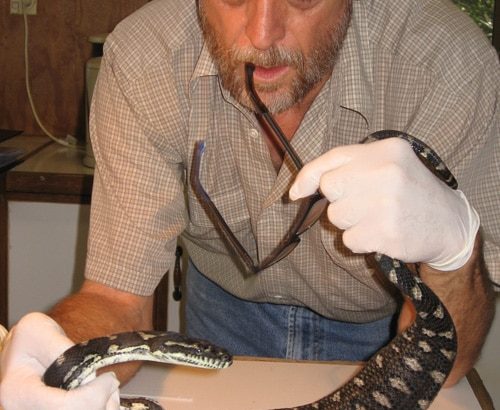Most people have the impression that birds are very tender, delicate, fragile, little creatures that will drop dead, die of fright or have a heart attack at a moment’s notice.
It’s easy to understand how this attitude has come about, although its totally erroneous. Birds actually aren’t delicate, but are very tough creatures. They’re descended from dinosaurs and have been around for a long time.
The way this attitude has come about, is that most people have been in the situation where they have a pet bird that is perching, apparently eating, looking normal and the next day, it’s lying on its back, feet in the air, dead. Therefore, owners are under the misapprehension that birds die suddenly. In actual fact, a visibly sick bird has been sick for quite some time. It has masked signs of being sick. This is called the preservation or masking reflex. Preservation reflex is very frustrating for the avian veterinarian. It usually means that, when a sick bird is presented to me, it is a dying bird.
The reason for this reflex is that most of our pet birds are flock and prey species e.g. parrots, canaries, finches, poultry and waterfowl. Prey species are eaten in the wild by predators. Most owners compare birds to the commonly kept pet, the dog, which is a domesticated animal. Humans have been domesticating it for 14,000 years. Whereas birds are still wild animals. They are only one generation removed from the wild. They still have all of their wild instincts. Because they are flock and prey species, they don’t let on that they are sick, injured or weak, as they will be eaten. In the wild, predators are looking for easy meals. There is another important reason why the weaker birds don’t let on they are sick. They will be driven from the flock as the sick bird attracts predators. If they are expelled from the flock, they can’t survive on their own. The dog, on the other hand, is a predator. It has no reason to mask signs of illness. There is nothing out there ready to eat him. So, owners see straight away if their pet dog is off colour. He mopes around, he doesn’t eat his dinner or wag his tail.
The implication of this preservation reflex for the bird owner is that their pet is never going to let on that it is sick. The last people that it will reveal any signs of sickness or weakness to other members of its ‘human flock’. Pet birds will mask signs of sickness and pretend that they are okay until they are too sick to pretend any longer. It is usually at this stage that owners first notice that their pet is not well. The bird is weak, fluffed, not eating and not vocalising. When a bird can no longer hide signs of sickness, it is usually very sick or dying.
However, the observant pet bird owner can circumvent the preservation or masking reflex by learning to recognise the subtle signs that indicate their bird is not well. When a bird is sick, their appetite will decrease. As a result of decreased appetite, they will pass fewer droppings. They can’t hide that. By cleaning the cage daily the owner can check the droppings. Newspaper is the most efficient cage liner as droppings are clearly visible. Whereas in sand and grit, they are hidden.
Weight loss in a bird is another important indication that something is not right. it is easy to see if a pet dog is skinny or fat. However, a bird covered in feathers is like someone wearing an overcoat. It is difficult to judge by looking, whether a bird is fat or thin. Feathers mask their condition. Regular weighing and handling are the only effective ways to gauge the condition or a pet bird. Part of training a bird is to accustom them to being handled and felt all over. In this way, the owner can feel the condition of the pectoral muscles and the keel. Any significant weight loss should be investigated by your avian veterinarian.
It is also necessary to check food intake daily. A sick bird can pretend to eat by putting its head in the seed bowl and mouthing food. However, the observant owner will see there is no husked seed. As the cage is cleaned daily, always check whether food has actually been eaten.
Overcoming the preservation and masking reflex in birds is linked to so many other aspects of bird ownership (e.g. observation, training, cage-scaping, hygiene, attention to droppings). An understanding of bird behaviour and their preservation reflex will ensure a more rewarding relationship between the pet bird and their owner. It will also ensure successful outcomes from your visit to your avian veterinarian.
© Peter Wilson July 2010
Information supplied by (c) Currumbin Valley Vet Services August 2010
FAQs
If your bird is hiding its symptoms, it can be difficult to determine if it is sick. However, some signs to look for include a decrease in activity or vocalisation, changes in eating or drinking habits, and changes in feather condition or appearance. If you suspect your bird is sick, it is best to search for a “parrot vet near me” and have a consultation for a proper diagnosis.
If you suspect your bird is hiding its symptoms of illness, it is important to take it to a veterinarian as soon as possible. The veterinarian can perform a thorough examination and diagnose any underlying health problems. Providing a healthy diet, clean and comfortable environment, and regular veterinary check-ups can also help keep your bird healthy and less likely to hide symptoms when it is sick.





